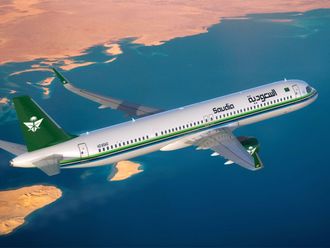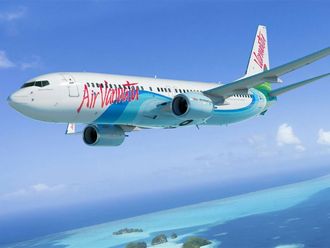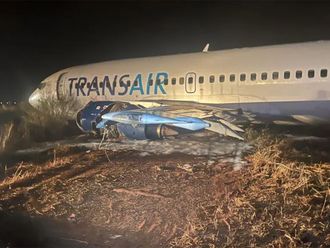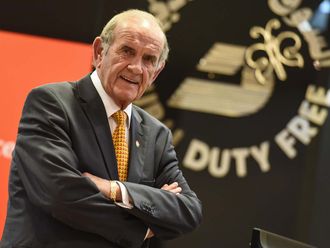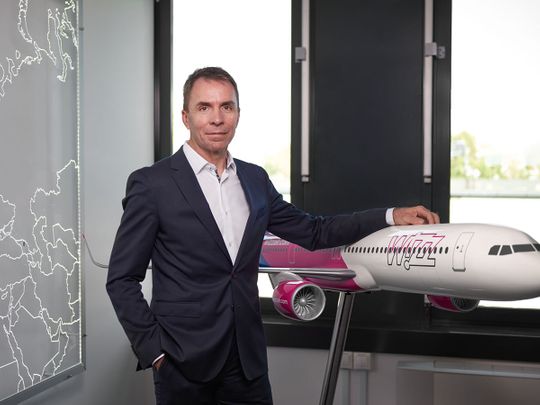
Dubai: The war in Ukraine, volatile fuel prices and Europe’s supply chain issues did throw a spanner in the works for Wizz Air - but the budget airline’s CEO is confident of turning a massive profit in the current financial year. József Váradi says the airline will be able to return to net profit of 350 million to 450 million euros from a net loss of 535.1 million euros the previous year.
In an interview with Gulf News, Váradi talks about profits and a broader airline industry transition to non-carbon-based travel. He also spoke about the launch of flights to India and Pakistan and the possibility of a new subsidiary airline.
Wizz Air carried 88.3 per cent more passengers in its latest financial year and saw revenues jump 134.2 per cent. Can this high-growth numbers be sustained?
We are looking at a net profit of 350 million to 450 million euros compared to the net loss previously. That’s roughly a billion euros into profitability year-on-year. Some of this will be direct revenue, some by improving the underlying cost performance, and some from a more favourable environment in terms of fuel and foreign exchange.
Read more
When you look at the dip in performance of the last financial year, most of it is because of under-performance in the first-half. That was the time when the war in Ukraine broke out, resulting in significant network reshuffling. We had to move aircraft and people as a result. That significantly affected our revenue generating capacity. Secondly, when we entered peak summer, the whole European supply chain system broke down.
We made significant efforts and investments to make sure we are more resilient when such issues arise, and already saw results in the second-half of the previous fiscal year. We expect this performance to continue.
Your airline cut net losses by 107.4 million euros in the given financial year. How did the company achieve this?
It was all about improving productivity and internal operations, increasing capacity on profitable routes, and optimising unproductive routes. Today, Wizz Air is among the best-performing airlines in Europe, with the fewest capacity cancellations.
Wizz Air is investing 5 million pounds in biofuel company Firefly and its Sustainable Aviation Fuel development process. You recently flew from Budapest with a 37 per cent SAF blend. Do you think enough is being done in this transition to SAF?
There are three stages. One is the current, where we are dealing with whatever technology is available and using it to its potential. Wizz Air is doing very well in that regard.
We have a fleet that’s mostly renewed, with an average age of 4-5 years. The fleet renewal and expansion have brought forward the benefits of new technology in ownership and operating cost, fuel consumption and lower carbon and noise emissions. As a result, our carbon footprint is among the lowest in the industry.
The second stage is the bridging stage, which is SAF. This is a further way of reducing carbon footprint. But two big factors — availability and cost — play a huge role here.
This requires investment and cost needs to come down to make it more affordable. At the moment, SAF production is going to more expensive, at least in the early stage. Perhaps we can look at a financing mechanism where various stakeholders come into play, such as governments, maybe the EU, etc.
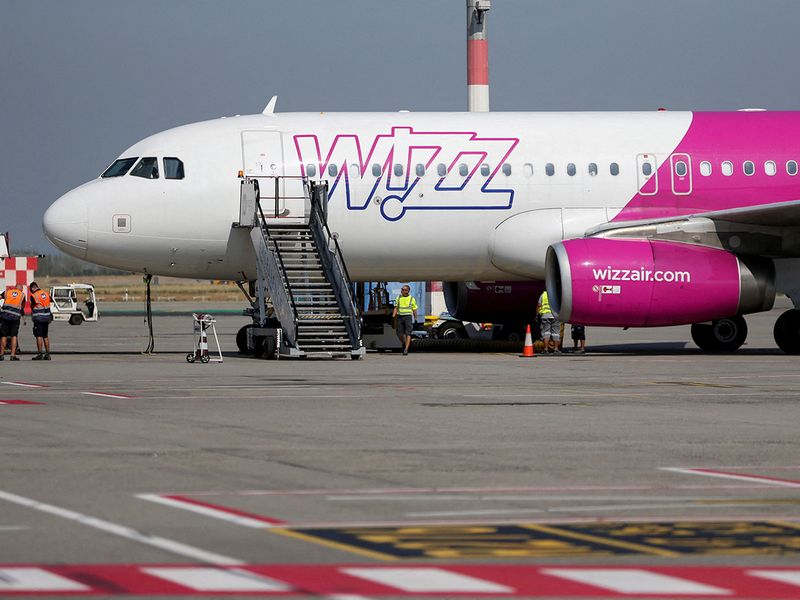
The third stage, which I think is critical, is the transition from carbon-based propulsion to non-carbon-based propulsion, which I think is going to be hydrogen.
How do you see OPEC’s latest announcement on oil output cuts impacting your revenue?
This needs a wait-and-watch approach. OPEC has been moving production rates on a fairly constant basis. We are largely hedged, and 60 per cent of our fuel requirements for the financial year has been hedged already, and continue to do so. Therefore, we shouldn’t see much volatility, at least in the short-term basis.
Let’s shift focus to the Gulf region now. When do we see Wizz Air Abu Dhabi starting flights to India and Pakistan?
It all depends on the approvals from the Indian and Pakistani authorities. That’s something we are still working on. It’s not possible to put a timeline to this — it could take three months or three years. We have to wait.
Wizz Air Abu Dhabi ferried 1.2 million passengers in 2022. What are your projections for 2023?
We are seeing a lot of demand for Wizz Air Abu Dhabi. We are already expanding our fleet, set to grow from nine to 16 aircraft in the next 12 months. Our hiring program is also on track.
This market has potential to become a 50-aircraft operation by the end of the decade.
Wizz Air has an order backlog of 365 aircraft. How has the manpower crisis and supply-side shortage in Europe impacted your deliveries?
If we see the current situation, there are delays on the manufacturing side. But we are getting the aircraft as per our plan for the respective financial years.
You recently launched a subsidiary in Malta. Are there any plans to introduce more subsidiaries?
It’s possible. We already have four airlines at the moment - Hungary, UK, Abu Dhabi and Malta. So subsidiaries are part of our operational model. We are very excited about the broader Middle East, including the Gulf, and Central Asia.
We are seeing significant expansion of Wizz Air in that region and there’s high consumer demand. These regions offer good prospect for an AOC (air operator certificate) in the future.
We find that Wizz Air mostly has planes from the A320 and A321 family. Any specific reason for this?
The Neo is the best narrow-body aircraft at the moment. It gives you the best economic and environmental performance compared to any other plane in this category. We will continue to operate these planes, it’s the best platform for us. There are no diversification plans at the moment.



